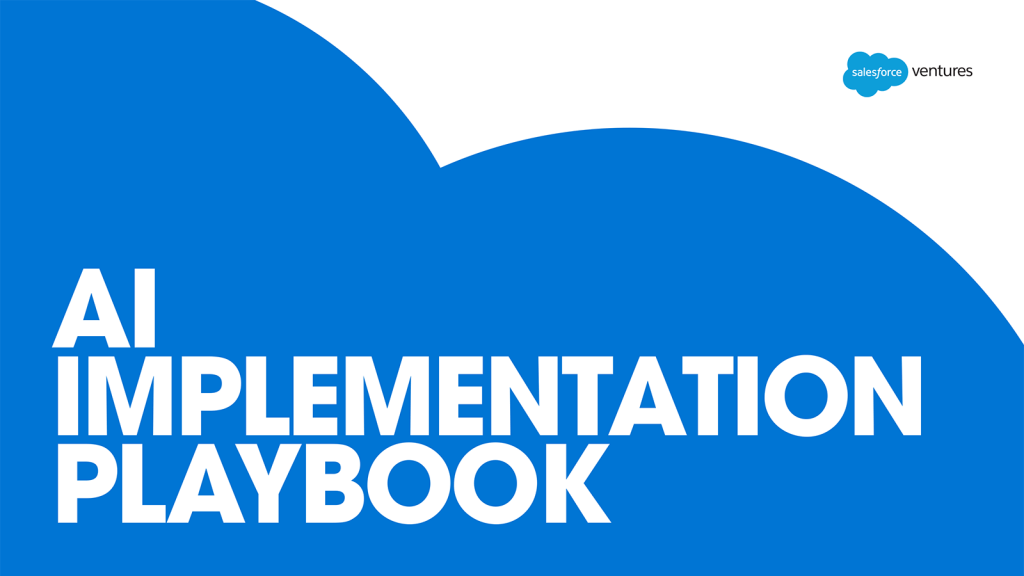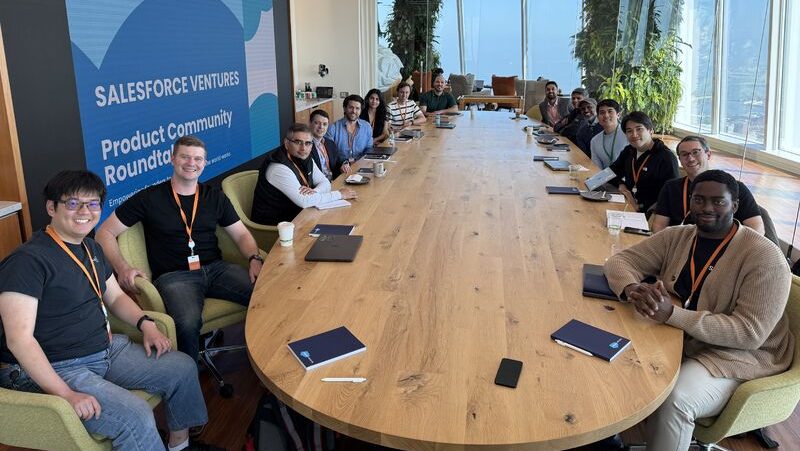The need to maximize the value of new AI models and tools is perhaps the top priority for companies both big and small in 2025.
The fear of not innovating fast enough is real.
At the same time, companies are experiencing challenges associated with AI implementation, including skepticism around the effectiveness and accuracy of AI tools and resistance to change by employees.
In light of these challenges, the Salesforce Ventures Portfolio Development team recently hosted a roundtable discussion with product leaders from across the Salesforce Ventures portfolio, including Airtable, Autify, Candidly, Copado, DataRobot, Endor Labs, Pano AI, Protect AI, Runway, and SRE.ai, as well as representatives from Salesforce’s IT enterprise architecture team. As a group, we found common ground around the goals and challenges of AI implementation, and shared a number of strategies and tactics that can be useful to any organization or team working to adapt in the AI age.
Here are a few key insights from our workshop.
Key Insight 1: Set Your Culture Up for Success
Successful AI implementation starts with a strong company culture. Product leaders at our workshop emphasized the need to confront head-on the employee apprehension that comes with adopting new AI tools in the workplace.
- Recognize the sources and signals of AI skepticism: Employees may express concerns about job displacement or feel an existential dread about their career prospects. Engineering teams, in particular, might be skeptical of AI’s non-deterministic nature or its ability to handle complex tasks.
- Show your work: Leaders can recast AI adoption not as a threat, but as a means to improve output and augment roles. One product leader shared how his team demonstrated the value of AI in overcoming “blank page syndrome,” which encouraged further usage of AI throughout the organization. He emphasized that AI can help get work to “80% fidelity,” allowing humans to make the final 20% as good as it can be. Similarly, we heard how another team built an internal app that runs AI pipelines against recorded sales calls to automate tasks like drafting competitive messaging and identifying beta customers. Showcasing the “art of the possible” through demos, case studies, and success stories can inspire widespread adoption across the organization.
- Encourage experimentation: Consistent access to various AI tools allows teams to experiment and discover innovative uses. A product leader shared that he encouraged his engineers to use AI to hack on non-production code, which led to the creation of useful scripts that save his team time. He said giving engineers ownership and the ability to customize their workflows can ease skepticism and encourage AI adoption.
Key Insight 2: Choose Tools With Intentional Goals
With so many different AI tools to choose from, a strategic approach to selection and implementation helps frame and focus objectives.
- Know which tasks you want to target: Many workshop participants highlighted AI’s positive impact on productivity for tasks like prototyping, writing documentation, and summarizing information. Multiple teams use tools like Cursor and Claude to help outline and draft better Product Requirements Documents (PRDs). Attendees agreed you should have an idea of what tasks you’re trying to improve with AI before you go shopping for a solution.
- Give employees space to learn & iterate: Effective AI use goes beyond single-shot prompting. One product leader described how his team chats directly with Google’s Gemini about code, conventions, and design processes, and then asks it to generate foundational prompts for engineering tasks. Learning how to get the most out of your AI tooling requires continuous interaction and iteration, especially as AI models improve over time.
Key Insight 3: Re-Evaluate Workflows Leveraging AI
AI’s true power is unlocked when integrated well into existing workflows or when defining new workflows with AI baked in from the ground up. This especially applies to workflows involving multiple stakeholders and cross-functional collaboration.
- Identify opportunities in the software development life cycle (SDLC): AI is already significantly impacting SDLCs by helping generate design specifications, technical documentation, and aiding in testing. One of our product leaders shared how their in-house LLM, trained on Salesforce development tools, helps annotate code and write release notes. Our attendees agreed that there are many opportunities to shorten the SLDC by embedding AI in key areas.
- Consider how AI can bring teams closer: Our attendees emphasized that AI gives them a much larger context window, enabling them to have higher-caliber conversations with their design and engineering teams and allowing them to focus more on end-users. The more that enablement initiatives can cut across multiple functions and teams, the more likely companies will experience sustained adoption and long term success. By having AI worry about the details, team members can shift their focus to become generalists — building better credibility and empathy with their colleagues.
Key Insight 4: Be Realistic
While AI holds tremendous potential for product teams, it’s important to acknowledge its current limitations and the complexities of its implementation.
- Be mindful of security: A significant concern raised by attendees was the security implications of integrating AI into large ecosystems of existing applications and the need for best practices like data audits and pipeline observability. The immaturity of AI systems in handling identity information and the lack of vector databases with proper granular permissions through the entire knowledge pipeline was repeatedly cited as a challenge by our attendees. Also, the risk of internal threats, such as a bad actor maliciously modifying a model, highlights the need for robust security measures. As of today, the challenge of agentic security — ensuring safety when AI agents creatively choose and combine tools — is still a problem the market hasn’t solved.
- Be aware of other rollout complexities: Testing systems that rely heavily on non-deterministic agentic responses presents a major hurdle. Some methods shared by our teams included using AI red-teaming tools and building and using automated testing processes incorporating “challenger agents” to evaluate agent responses (i.e., agents testing agents). Difficulty integrating AI with open-source tooling and incompatible permissioning systems can further complicate AI rollouts.
From Hype to Tangible Value
Implementing AI and leveraging its ability to increase productivity is not without challenges. Leaders should endeavor to bring teams together to identify specific use cases and workflows where AI can handle repetitive, granular tasks. A thoughtful AI-first strategy shifts the balance of work towards revising, polishing, critical thinking, and strategy. Starting with culture, modeling desired behaviors, and identifying concrete opportunities for near-term benefits can and will drive adoption.
Beyond the insights shared by our attendees, companies should consider additional factors that feed into a successful strategy for implementing AI, such as measuring success with relevant KPIs, policy frameworks for AI governance and ethics, and a vendor and ecosystem strategy to inform building vs. buying capabilities. Salesforce Ventures will continue working with our portfolio companies to support a more cohesive and thoughtful approach to harnessing the transformative power of AI.
_
The Salesforce Ventures Portfolio Development team hosts events regularly for founders and executives in our corporate network to share trends, insights, and best practices in emerging technologies and connect leaders within our communities. To hear about future events, sign up for our newsletter >>>






